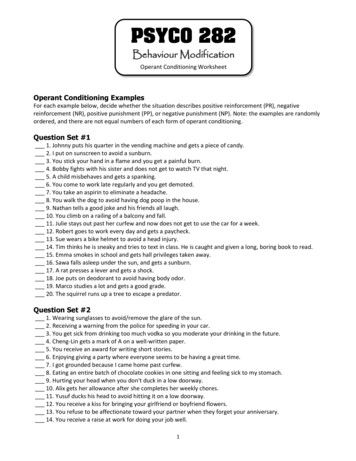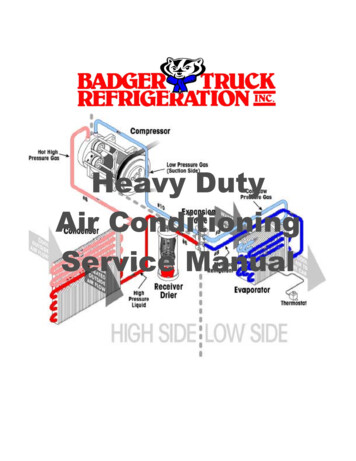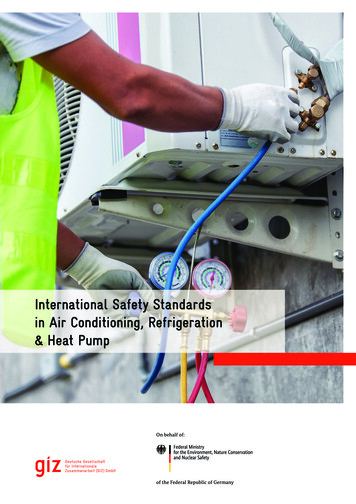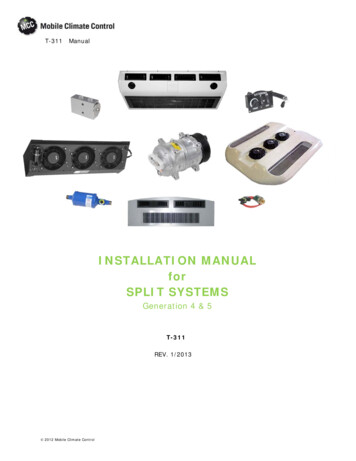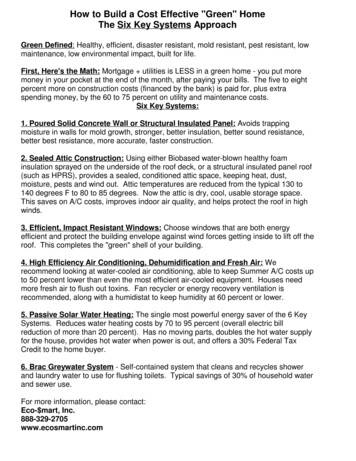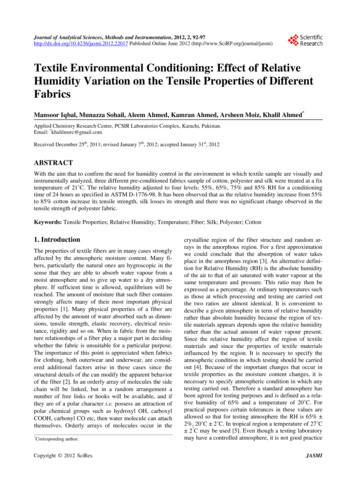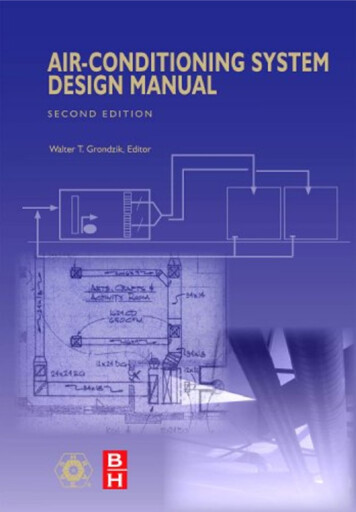
Transcription
PREFACEThis second edition represents a major update and revision ofthe ASHRAE Air-Conditioning System Design Manual. Therequest that drove this revision effort was simply to make a successful resource more current. The revision process involved a thoroughediting of all text in the manual, the addition of SI units throughout,the updating of references, and the editing of many illustrations.New material dealing with design process, indoor air quality, desiccant dehumidification, and “green” HVAC&R systems was added.The editor acknowledges the active assistance of a ProjectMonitoring Subcommittee (with Warren Hahn as Chairman) fromASHRAE Technical Committee 9.1, which supervised the revisionof this manual. The editor and committees are grateful to severalindividuals who reviewed all or parts of the draft of this revisionand made valuable suggestions for improvements and clarifications(see list of contributors). Andrew Scheidt, University of Oregon,provided graphic assistance for the editing of many illustrations.Walter Grondzik, PE, Editorix
ACKNOWLEDGMENTSLIST OF CONTRIBUTORSFinal Voting Committee MembersDennis J. Wessel, PE, LEEDKarpinski Engineering, Inc.John L. Kuempel Jr.Debra-KuempelStephen W. Duda, PERoss & Baruzzini, Inc.Kelley Cramm, PEIntegrated Design EngineeringAssociatesRodney H. Lewis, PERodney H. Lewis Associates, Inc.John E. Wolfert, PERetiredHoward J. McKew, PE, CPERDK Engineers, Inc.Phillip M. Trafton, VCDonald F. Dickerson AssociatesMark W. Fly, PEAAON, INc.Gene R. Strehlow, PEJohnson Controls, Inc.Hollace S. Bailey, PE, CIAQPBailey Engineering CorporationLynn F. Werman, PESelf-EmployedCharles E. Henck, PE, LEEDWhitman, Requardt & AssociatesHarvey BrickmanWarren G. Hahn, PECEO, Hahn Engineering, Inc.K. Quinn Hart, PEUS Air Force Civil EngineerSupport AgencyWilliam K. Klock, PEEEA Consulting Engineers, Inc.John I. VucciUniversity of Marylandxi
Other Major Contributors and Reviewers(Only major reviewers and contributors are listed. The committee isvery thankful to numerous individuals who freely gave their time toreview special parts of this manual.)Charles G. Arnold, PEHDR One CompanyArthur D. Hallstrom, PETraneRodney H. Lewis, PERodney H. Lewis AssociatesDavid Meredith, PEPenn State Fayette, The EberlyCampusJoseph C. HooseCool Systems, Inc.James Wilhelm, PERetiredPaul A. Fiejdasz, PEMember ASHRAEHank Jackson, PEMember ASHRAEJohn G. Smith, PEMichaud Cooley Erickson Consulting EngineersWilliam G. AckerAcker & AssociatesChuck Langbein, PERetiredA special thanks to John Smith, David Meredith, and ChuckLangbein, who reviewed and commented on each chapter throughall revisions.Warren G. Hahn, PE, TC 9.1, Air-Conditioning System DesignManual Update and Revision Subcommittee Chairmanxii
CHAPTER 1INTRODUCTION1.1 PURPOSE OF THIS MANUALThis manual was prepared to assist entry-level engineers in thedesign of air-conditioning systems. It is also usable—in conjunction with fundamental HVAC&R resource materials—as a senioror graduate-level text for a university course in HVAC systemdesign. This manual was intended to fill the void between theoryand practice, to bridge the gap between real-world design practicesand the theoretical knowledge acquired in the typical college courseor textbook. Courses and texts usually concentrate on theoreticalcalculations and analytical procedures or they focus upon thedesign of components. This manual focuses upon applications.The manual has two main parts: (1) a narrative description ofdesign procedures and criteria organized into ten chapters and (2) sixappendices with illustrative examples presented in greater detail.The user/reader should be familiar with the general concepts ofHVAC&R equipment and possess or have access to the four-volumeASHRAE Handbook series and appropriate ASHRAE special publications to obtain grounding in the fundamentals of HVAC&R system design. Information contained in the Handbooks and in specialpublications is referenced—but not generally repeated—herein. Inaddition to specific references cited throughout the manual, a list ofgeneral references (essentially a bibliography) is presented at theend of this chapter.The most difficult task in any design problem is how to begin.The entry-level professional does not have experience from similarprojects to fall back on and is frequently at a loss as to where tostart a design. To assist the reader in this task, a step-by-stepsequence of design procedures is outlined for a number of systems.1
2 INTRODUCTIONSimple rules are given, where applicable, to assist the new designerin making decisions regarding equipment types and size.Chapter 2 addresses the difference between analysis anddesign. The chapter covers the basic issues that are addressed during the design phases of a building project and discusses a numberof factors that influence building design, such as codes and economic considerations. Human comfort and indoor air quality, andtheir implications for HVAC&R systems design, are discussed inChapter 3. Load calculations are reviewed in Chapter 4. The specifics of load calculation methodologies are not presented since theyare thoroughly covered in numerous resources and are typicallyconducted via computer programs. HVAC&R system componentsand their influence on system design are discussed in Chapter 5.Chapters 6 through 8 cover the design of all-air, air-and-water,and all-water systems, respectively. Here, again, a conscious effortwas made not to duplicate material from the ASHRAE Handbook—HVAC Systems and Equipment, except in the interest of continuity.Chapter 6 is the largest and most detailed chapter. Its treatment ofthe air side of air-conditioning systems is equally applicable to theair side of air-and-water systems; thus, such information is notrepeated in Chapter 7. Chapter 9 covers a variety of specialHVAC&R systems. Controls are treated in Chapter 10.The appendices contain detailed descriptions and design calculations for a number of actual HVAC&R-related building projects.They serve to illustrate the procedures discussed in the main bodyof the manual. The projects in the appendices were chosen to covera variety of building applications and HVAC system types. Theyhelp to give the entering professional a “feel” for the size ofHVAC&R equipment, and they indicate how a designer tackles particular design problems. Since these examples come from actualprojects, they include values (such as thermal properties, utilitycosts, owner preferences) that are particular to the specific contextsfrom which they were drawn. The purpose of the examples is toshow process, not to suggest recommended or preferred outcomes.A few words of advice: do not hesitate to make initial designassumptions. No matter how far off the specific values of a finalsolution they might prove to be, assumptions enable the designer tostart on a project and to gradually iterate and improve a proposeddesign until a satisfactory solution has been obtained. Frequently,more experienced colleagues may be able to assist by giving counsel and the benefit of their experience, but do not hesitate to plungeahead on your own. Good luck!
AIR-CONDITIONING SYSTEM DESIGN MANUAL 31.2 HOW BEST TO USE THIS MANUALThe following suggestions are made to obtain maximum benefit from this manual:1.2.3.4.5.Consider the general category of the building being designedand read the appropriate chapters in the ASHRAE Handbook—HVAC Applications and the ASHRAE Handbook—HVAC Systems and Equipment to determine likely systems to considerfor application to the project.Familiarize yourself with the theory and basic functions ofcommon HVAC&R equipment. The best sources for thisinformation are HVAC&R textbooks and the ASHRAE Handbook series.Read the chapters in this manual that address the systems ofinterest.Review the example problems in the appropriate appendices ofthis manual.Become familiar with state and local building codes, ASHRAEstandards and guidelines, and applicable National Fire Protection Association (NFPA) resources.Remember that this manual, in general, does not repeat information contained in ASHRAE Handbooks and special publications.You cannot, therefore, rely on this manual as the only reference fordesign work. As you gain experience, make notes of important concepts and ideas (what worked and what did not work) and keepthese notes in a readily accessible location. This manual is intendedto point the way toward building such a design database.The best design reference available is the experience of yourcolleagues and peers. While an attempt has been made in this manual to incorporate the experience of design professionals, no staticwritten material can replace dynamic face-to-face interaction withyour colleagues. Use every opportunity to pick their brains, and letthem tell you what did not work. Often, more is learned from failures than from successes.1.3 UNITSThe first edition of this manual was written using I-P (inchpound) units as the primary measurement system. In this edition SI(System International) units are shown in brackets following the I-Punits. Conversions to SI units are “soft approximations” with, forexample, 4 in. being converted as 100 mm (versus the more accu-
4 INTRODUCTIONrate conversion to 101.6 mm or use of a true SI commercial sizeincrement for a given product). See the ASHRAE guide “SI forHVAC&R” (available at no cost from the ASHRAE Web site,www.ashrae.org) for detailed information on preferred measurement units and conversion factors for HVAC&R design work.1.4 GENERAL BIBLIOGRAPHYIn addition to specific references listed in each of the chaptersof this manual, the following publications are generally useful toHVAC&R system designers. They should be available in everydesign office. ASHRAE publications are available from the American Society of Heating, Refrigerating and Air-Conditioning Engineers, Inc., 1791 Tullie Circle, NE, Atlanta, GA 30329-2305.ASHRAE publications are updated on a regular basis (every fouryears for handbooks, often more frequently for standards andguidelines). The publication dates shown below are current as of theupdating of this manual but will change over time. Consult theASHRAE Web site (www.ashrae.org) for information on currentpublication dates.ASHRAE Handbooks(available on CD or as printed volumes, in I-P or SI units)ASHRAE. 2003. 2003 ASHRAE Handbook—HVAC Applications.Atlanta: American Society of Heating, Refrigerating and AirConditioning Engineers, Inc.ASHRAE. 2004. 2004 ASHRAE Handbook—HVAC Systems andEquipment. Atlanta: American Society of Heating,Refrigerating and Air-Conditioning Engineers, Inc.ASHRAE. 2005. 2005 ASHRAE Handbook—Fundamentals.Atlanta: American Society of Heating, Refrigerating and AirConditioning Engineers, Inc.ASHRAE. 2006. 2006 ASHRAE Handbook—Refrigeration.Atlanta: American Society of Heating, Refrigerating and AirConditioning Engineers, Inc.ASHRAE Standards and GuidelinesASHRAE. 1995. ANSI/ASHRAE Standard 100-1995, EnergyConservation in Existing Buildings. Atlanta: American Societyof Heating, Refrigerating and Air-Conditioning Engineers, Inc.ASHRAE. 1996. ASHRAE Guideline 1-1996, The HVACCommissioning Process. Atlanta: American Society ofHeating, Refrigerating and Air-Conditioning Engineers, Inc.
AIR-CONDITIONING SYSTEM DESIGN MANUAL 5ASHRAE. 2004a. ANSI/ASHRAE Standard 55-2004, ThermalEnvironmental Conditions for Human Occupancy. Atlanta:American Society of Heating, Refrigerating and AirConditioning Engineers, Inc.ASHRAE. 2004b. ANSI/ASHRAE Standard 62.1-2004, Ventilationfor Acceptable Indoor Air Quality. Atlanta: American Societyof Heating, Refrigerating and Air-Conditioning Engineers, Inc.ASHRAE. 2004c. ANSI/ASHRAE Standard 62.2-2004, Ventilationand Acceptable Indoor Air Quality in Low-Rise ResidentialBuildings. Atlanta: American Society of Heating, Refrigeratingand Air-Conditioning Engineers, Inc.ASHRAE. 2004d. ANSI/ASHRAE/IESNA Standard 90.1-2004,Energy Standard for Buildings Except Low-Rise ResidentialBuildings. Atlanta: American Society of Heating, Refrigeratingand Air-Conditioning Engineers, Inc.ASHRAE. 2004e. ANSI/ASHRAE Standard 90.2-2004, EnergyEfficient Design of Low-Rise Residential Buildings. Atlanta:American Society of Heating, Refrigerating and AirConditioning Engineers, Inc.ASHRAE. 2005a. ASHRAE Guideline 0-2005, The CommissioningProcess. Atlanta: American Society of Heating, Refrigeratingand Air-Conditioning Engineers, Inc.Other ASHRAE PublicationsASHRAE. 1991. ASHRAE Terminology of HVAC&R. Atlanta:American Society of Heating, Refrigerating and AirConditioning Engineers, Inc.ASHRAE. 1997. SI for HVAC&R. Atlanta: American Society ofHeating, Refrigerating and Air-Conditioning Engineers, Inc.ASHRAE. 1998. Cooling and Heating Load CalculationPrinciples. Atlanta: American Society of Heating,Refrigerating and Air-Conditioning Engineers, Inc.ASHRAE. 2002. Psychrometric Analysis (CD). Atlanta: AmericanSociety of Heating, Refrigerating and Air-ConditioningEngineers, Inc.ASHRAE. 2004f. Advanced Energy Design Guide for Small OfficeBuildings. Atlanta: American Society of Heating, Refrigeratingand Air-Conditioning Engineers, Inc.ASHRAE. 2005b. ASHRAE Pocket Guide for Air Conditioning,Heating, Ventilation, Refrigeration. Atlanta: American Societyof Heating, Refrigerating and Air-Conditioning Engineers, Inc.
6 INTRODUCTIONASHRAE. 2005c. Principles of Heating, Ventilating and AirConditioning. Atlanta: American Society of Heating,Refrigerating and Air-Conditioning Engineers, Inc.ASHRAE. 2006a. Advanced Energy Design Guide for Small RetailBuildings. Atlanta: American Society of Heating, Refrigeratingand Air-Conditioning Engineers, Inc.ASHRAE. 2006b. ASHRAE GreenGuide: The Design,Construction, and Operation of Sustainable Buildings. Atlanta:ASHRAE and Elsevier/B-H.NFPA Publications(updated on a regular basis)NFPA. 2000. NFPA 92A-2000, Recommended Practice for SmokeControl Systems. Quincy, MA: National Fire ProtectionAssociation.NFPA. 2002. NFPA 90A-2002, Installation of Air Conditioning andVentilating Systems. Quincy, MA: National Fire ProtectionAssociation.NFPA. 2003. NFPA 101-2003, Life Safety Code. Quincy, MA:National Fire Protection Association.NFPA. 2005. NFPA 70-2005, National Electrical Code. Quincy,MA: National Fire Protection Association.Other ResourcesClimatic Data:Climatic Atlas of the United States. 1968. U.S. GovernmentPrinting Office, Washington, DC.Ecodyne Corporation. 1980. Weather Data Handbook. New York:McGraw-Hill.Kjelgaard, M. 2001. Engineering Weather Data. New York:McGraw-Hill.USAF. 1988. Engineering Weather Data, AFM 88-29. U.S.Government Printing Office, Washington, DC.Estimating Guides:Konkel, J. 1987. Rule-of-Thumb Cost Estimating for BuildingMechanical Systems. New York: McGraw-Hill.R.S. Means Co. 2005. Means Mechanical Cost Data, 28th ed.Kingston, MA.
AIR-CONDITIONING SYSTEM DESIGN MANUAL 7R.S. Means Co. 2005. Means Facilities Construction Cost Data,20th ed. Kingston, MA.Thomson, J. 2004. 2005 National Plumbing & HVAC Estimator.Carlsbad, CA: Craftsman Book Company.General Resources:BOMA. 2004. Experience Exchange Report. An annual publicationof the Building Owners & Managers Association International,Washington, DC.McQuiston, F.C., and J.D. Spitler. 1992. Cooling and Heating LoadCalculation Manual. Atlanta: American Society of Heating,Refrigerating and Air-Conditioning Engineers, Inc.SMACNA. 1988. Duct System Calculator. Chantilly, VA: SheetMetal and Air Conditioning Contractors’ National Association.SMACNA. 1990. HVAC Systems—Duct Design, 3d ed. Chantilly,VA: Sheet Metal and Air Conditioning Contractors’ NationalAssociation.USGBC. 2005. LEED-NC (Leadership in Energy andEnvironmental Design—New Construction). U.S. GreenBuilding Council, Washington, DC. (Look also for informationregarding other USGBC green building certificationprograms.)A number of equipment manufacturers have developed HVACdesign manuals and/or equipment application notes. These are notspecifically listed here, in accordance with ASHRAE’s commercialism policy, but are recommended as sources of practical designand application advice. A search of manufacturers’ Web sites (formanuals or education) will usually show what is currently available(for free or for a fee).An extensive list of applicable codes and standards, includingcontact addresses for promulgating organizations, is provided in aconcluding chapter in each of the ASHRAE Handbooks.
CHAPTER 2THE DESIGN PROCESS2.1 DESIGN PROCESS CONTEXTThere are numerous variations of the design process, perhapsas many as there are designers. To try and place the following information into a common context, the design process structure used inASHRAE Guideline 0-2005, The Commissioning Process(ASHRAE 2005a) will be used. For purposes of building commissioning, the acquisition of a building is assumed to flow throughseveral broad phases: predesign, design, construction, and occupancy and operation. The design phase is often broken into conceptual design, schematic design, and design development subphases.Although the majority of design hours will be spent in the designdevelopment phase, each of these phases plays a critical role in asuccessful building project. Each phase should have input from theHVAC&R design team. The HVAC&R design team should strive toprovide input during the earliest phases (when HVAC&R designinput has historically been minimal) since these are the most criticalto project success, as they set the stage for all subsequent work.Design should start with a clear statement of design intent. Incommissioning terms, the collective project intents form theOwner’s Project Requirements (OPR) document. Intent is simply adeclaration of the owner’s (and design team’s) needs and wants interms of project outcomes. HVAC&R design intents might includeexceptional energy efficiency, acceptable indoor air quality, lowmaintenance, high flexibility, and the like. Each design intent mustbe paired with a design criterion, which provides a benchmark forminimum acceptable performance relative to the intent. For example, an intent to provide thermal comfort might be benchmarked viaa criterion that requires compliance with ANSI/ASHRAE Standard55-2004, Thermal Environmental Conditions for Human Occupancy (ASHRAE 2004b), and an intent for energy efficiency might9
10 THE DESIGN PROCESSbe benchmarked with a criterion that requires compliance withANSI/ASHRAE/IESNA Standard 90.1, Energy Standard for Buildings Except Low-Rise Residential Buildings.Design validation involves the use of a wide range of estimates, calculations, simulations, and related techniques to confirmthat a chosen design option will in fact meet the appropriate designcriteria. Design validation is essential to successful design; otherwise there is no connection between design intent and design decisions. Pre- and post-occupancy validations are also important toensure that the construction process and ensuing operational procedures have delivered design intent. Such validations are a keyaspect of building commissioning.2.2 DESIGN VERSUS ANALYSISAnyone who has taken a course in mathematics or any of thephysical sciences is familiar with the process of analysis. In a typical analysis, a set of parameters is given that completely describes aproblem, and the solution (even if difficult to obtain) is unique.There is only one correct solution to the problem; all other answersare wrong.Design problems are inherently different—much different. Adesign problem may or may not be completely defined (some of theparameters may be missing) and there are any number of potentiallyacceptable answers. Some solutions may be better than others, butthere is no such thing as a single right answer to a design problem.There are degrees of quality to design problem solutions. Somesolutions may be better (often in a qualitative or conceptual sense)than others from a particular viewpoint. For a different context orclient, other solutions may be better. It is important to clearlyunderstand the difference between analysis and design. If you areused to looking for the correct answer to a problem (via analysis),and are suddenly faced with problems that have several acceptableanswers (via design), how do you decide which solution to select?Learn to use your judgment (or the advice of experienced colleagues) to weigh the merits of a number of solutions that seem towork for a particular design problem in order to select the bestamong them.Figures 2-1 and 2-2 illustrate the analysis and design processes, respectively. Analysis proceeds in a generally unidirectionalflow from given data to final answer with the aid of certain analytical tools. Design, however, is an iterative process. Although thereare certain “givens” to start with, they are often not immutable but
AIR-CONDITIONING SYSTEM DESIGN MANUAL 11Figure 2-1. Diagram illustrating analysis.subject to modification during the design process. For example, anowner or architect may be confronted with the energy implicationsof excessively large expanses of glass that had been originally specified and may decide to reduce the area of glazing or change theglazing properties. The mechanical designer may try various system components and control strategies before finding one that bestsuits the particular context and conditions. Thus, design consists ofa continuous back-and-forth process as the designer selects from auniverse of available systems, components, and control options tosynthesize an optimum solution within the given constraints. Thisiterative design procedure incorporates analysis. Analysis is animportant part of any design.Since the first step in design is to map out the general boundaries within which solutions are to be found, it may be hard to knowwhere and how to start because there is no background from whichto make initial assumptions. To overcome this obstacle, makeinformed initial assumptions and improve on them through subsequent analysis. To assist you in making such initial assumptions,simple rules are given throughout the chapters in this manual, andillustrative examples are provided in the appendices.2.3 DESIGN PHASESA new engineer must understand how buildings are designed.Construction documents (working drawings and specifications)
12 THE DESIGN PROCESSFigure 2-2. Diagram illustrating design.for a building are developed as a team effort. The architect usuallyacts as the prime design professional and project coordinator,although experienced owners and developers may deal directlywith pre-selected HVAC&R consultants. The architect interfaceswith the owner, directs the architectural staff, and coordinates thework of outside or in-house mechanical, electrical, and structuralengineers (among other consultants). The negotiated design feesfor the consultants’ work establish an economically viable level ofeffort. This fiscal constraint usually seriously limits the amount oftime that can be allocated to studies of alternative systems orinnovative approaches.The project phases outlined below are those adopted byASHRAE Guideline 0-2005 and are those generally recognized bythe architecture profession. More explicit phases may be defined forcertain projects or under certain contracts.
AIR-CONDITIONING SYSTEM DESIGN MANUAL 132.3.1 Predesign PhaseBefore a mechanical engineer can design an HVAC system, abuilding program must be created. This is usually prepared by theclient or his/her consultants. The program establishes space needsand develops a project budget. The building program shouldinclude, but need not be limited to, the following: The client’s objectives and strategies for the initial andfuture functional use of the building, whether it be a singleor multiple-family dwelling or a commercial, industrial, athletic, or other facility.A clear description of function(s) for each discrete area withinthe building.The number, distribution, and usage patterns of permanentoccupants and visitors.The type, distribution, and usage patterns of owner-providedheat-producing equipment.The geographic site location, access means, and applicablebuilding and zoning codes.The proposed building area, height, number of stories, andmechanized circulation requirements.The owner’s capital cost and operating cost budgets.A clear statement of anticipated project schedule and/or timeconstraints.A clear statement of required or expected project quality.Although some of this information may not be available beforethe mechanical designer starts to work, it must be obtained as soonas possible to ensure that only those HVAC&R systems that arecompatible with the building program are considered.While the architect prepares the general building program, themechanical engineer has the responsibility of developing a discipline-specific program even though some of this information maybe provided by the architect or owner. The building program anduse profile provided by the owner or architect and the HVAC&Rsystems program developed by the engineer in response to thebuilding functional program should be explicitly documented forfuture reference. This documentation is termed the Owner’s ProjectRequirements (OPR) by ASHRAE Guideline 0-2005, and it provides the context for all design decisions. All changes made to theprogram during the design process should be recorded so that thedocumentation is always up-to-date.
14 THE DESIGN PROCESSThe information that should be contained in the HVAC&R system program includes design outdoor dry-bulb and wet-bulb temperatures (absoluteand coincident);heating and cooling degree-days/hours;design wind velocity (and direction) for winter and summer;applicable zoning, building, mechanical, fire, and energycodes; andrate structure, capacity, and characteristics of available utilitiesand fuels.Additional information regarding solar radiation availabilityand subsurface conditions would be included if use of a solar thermal system or ground-source heat pump was anticipated.The environmental conditions to be maintained for each building space should be defined by dry-bulb and wet-bulb temperatures during daytime occupiedhours, nighttime occupied hours, and unoccupied hours;ventilation and indoor air quality requirements;any special conditions, such as heavy internal equipment loads,unusual lighting requirements, noise- and-vibration-free areas,humidity limits, and redundancy for life safety and security; andacceptable range of conditions for each of the above.An understanding of the functional use for each area is essential to select appropriate HVAC&R systems and suitable controlapproaches because the capabilities of proposed systems must beevaluated and compared to the indoor environmental requirements.For example, if some rooms in a building require humidity controlwhile others do not, the HVAC system must be able to providehumidification to areas requiring it without detriment to the building enclosure or other spaces. Some areas may require cooling,while others need only ventilation or heating. This will affect selection of an appropriate system.2.3.2 Design PhaseIn conventional (business-as-usual) building projects, seriouswork on HVAC&R system design typically occurs in the laterstages of the design phase. Projects where energy efficiency and/orgreen building design are part of the intent or building types whereHVAC&R systems are absolutely integral to building design (labo-
AIR-CONDITIONING SYSTEM DESIGN MANUAL 15ratories, hospitals, etc.), will see HVAC&R design begin earlier andplay a more integrated role in design decision making.The design phase is often broken down into three subphases:conceptual design, schematic design, and design development. Theterms schematic design, design development, and constructiondocuments are also commonly used to describe design process subphases. The purpose of conceptual/schematic design efforts is todevelop an outline solution to the OPR that captures the owner’sattention, gets his/her buy-in for further design efforts, and meetsbudget. Schematic (or early design development) design effortsshould serve as proof of concept for the earliest design ideas aselements of the solution are further developed and locked intoplace. During later design development/construction documents,the final drawings and specifications are prepared as all designdecisions are finalized and a complete analysis of system performance is undertaken.The schematic/early design development stage should involvethe preliminary selection and comparison of appropriate HVAC&Rsystems. All proposed systems must be able to maintain the environmental conditions for each space as defined in the OPR. Theability to provide adequate thermal zoning is a critical aspect ofsuch capability. For each system considered during this phase, evaluate the relative space (and volume) requirements for equipment,ducts, and piping; fuel and/or electrical use and thermal storagerequirements; initial and life-cycle costs; acoustical requirementsand capabilities; compatibility with the building plan and the structural system; and the effects on indoor air quality, illumination, andaesthetics. Also consider energy code compliance and green designimplications (as appropriate).Early in the design phase, the HVAC&R designer may be askedto provide an evaluation of the impact of building envelope designoptions (vis-à-vis energy code compliance and trade-offs and/orgreen building intents), heavy lighting loads (i.e., more than 2 W/ft2[22 W/m2]), and other unusual internal loads (i.e., more than 4 W/ft2[43 W/m2]) on HVAC system performance and requirements. Questions should also be expected regarding the optimum location ofmajor mechanical equipment—considering spatial efficiency, system effectiveness, aesthetics, and acoustical criteria. Dependingupon the level of information available, the designer may be asked toprepare preliminary HVAC system sizing or performance estimatesbased upon patterns developed throug
the ASHRAE Air-Conditioning System Design Manual. The request that drove this revision effo rt was simply to make a success-ful resource more current. The revision process involved a thorough editing of all text in the manual, the addition of SI units throughout, the updat

